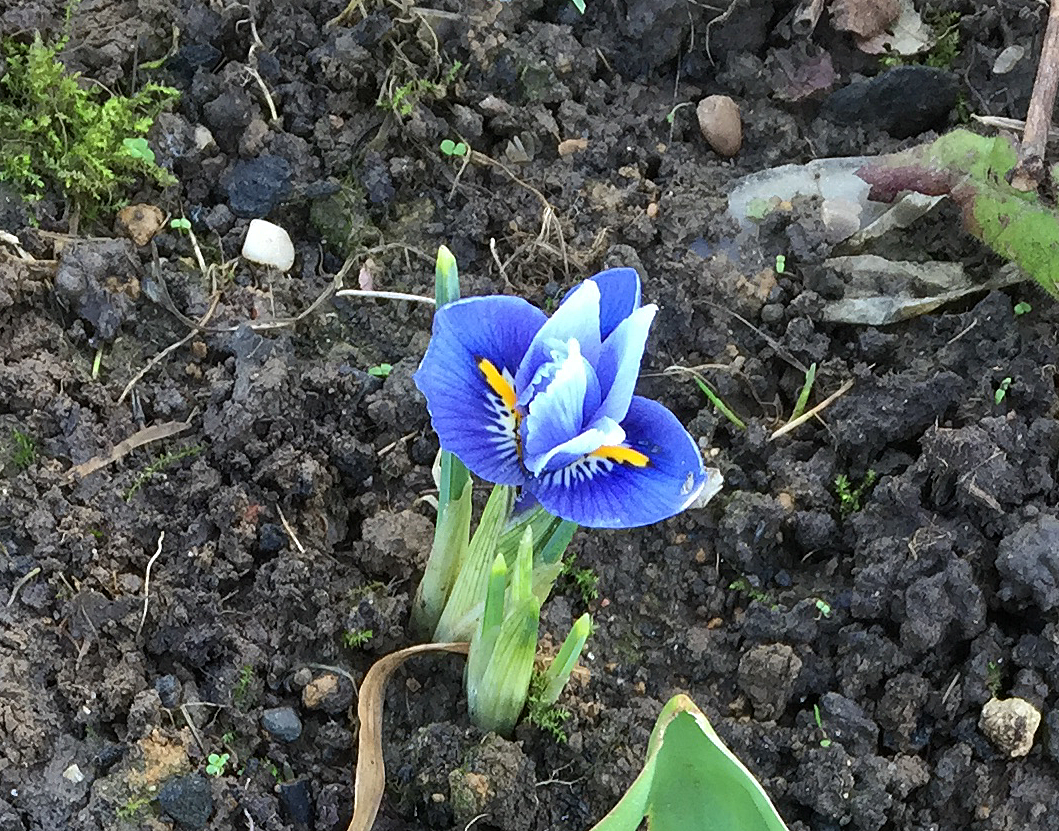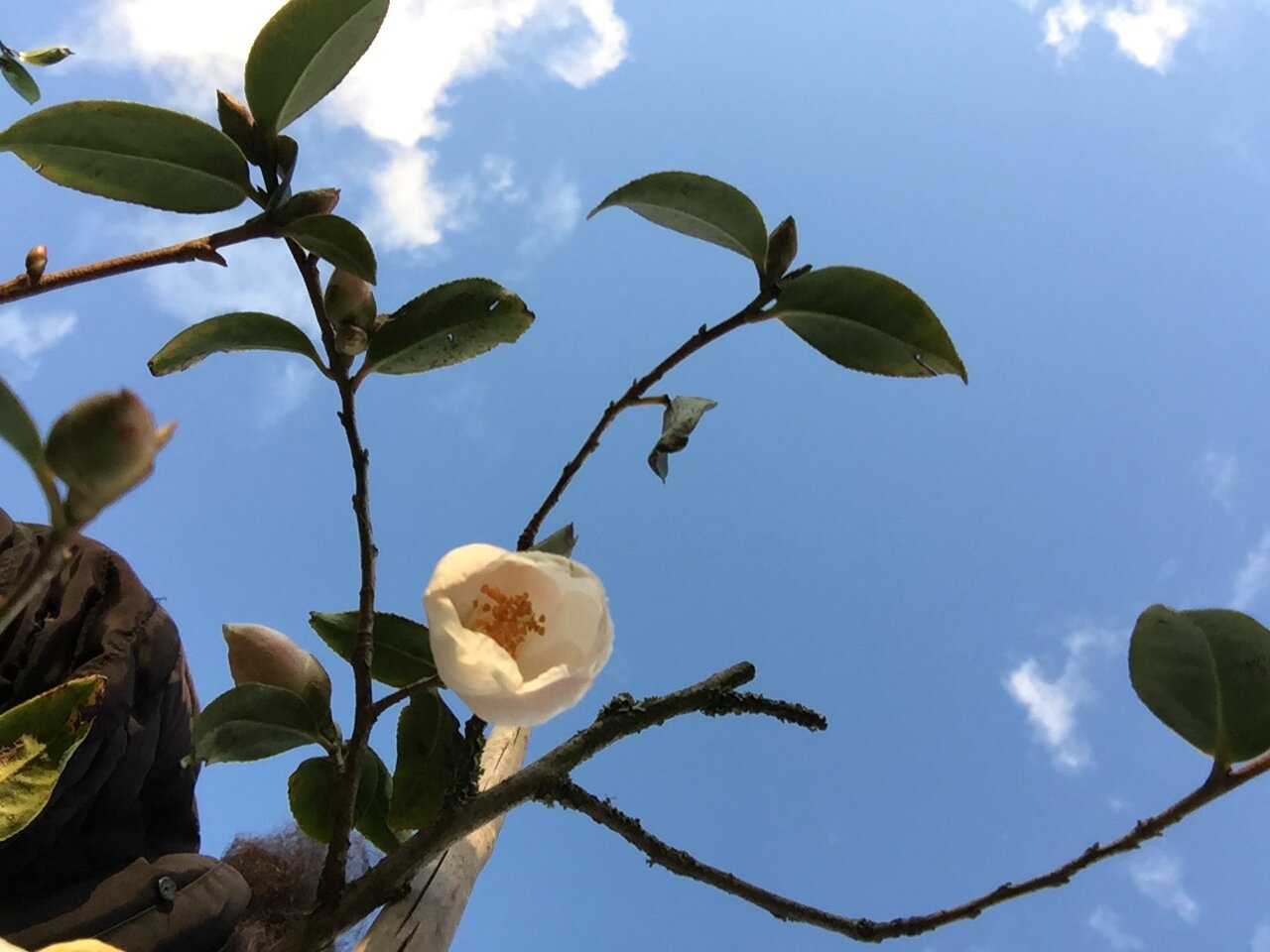Blooming NOW! February 2020
Taking a walk around my allotment plots, just LOOK what I saw … ki ni mo ri!
A Snowdrop!
A first, I found this single snowdrop flower in a pot that was home to a fruit tree recently donated to the allotment society by a member.
A little joy! My first snowdrop in 4 years! Well, it’s not mine really, but I am the custodian of the fruit tree until it is planted in the orchard, so I’m happy to associate myself with it. I haven’t had much luck with snowdrops in recent years. That’s another story for another time.
‘Galanthus’ is the botanical name for the snowdrop, which can be found across Europe and parts of Asia, from the Pyrennes to Iran. There are 20 different species and many cultivars. Galathus nivalis is naturalised in the UK, following it’s possible introduction by the Romans in the 16th century. Many consider the snowdrop to be a UK native wild flower. They grow well in semi-shaded woodland settings. They’re great for pots too.
I was so thrilled to see it! Soon, that single snowdrop was joined by a few others in the pot, of both the single- and doubled-petaled form.
Snowdrops are a symbol of hope in the UK, an early reminder that spring is not far away. The days are getting longer. Sleeping nature is beginning to stir.
Tiny snowdrops nod daintily and prettily in the breeze, heads downwards. I’m told they are breath-taking in drifts, but I have only seen them en masse in pictures. The National Garden Scheme offers information on gardens across the UK where snowdrop displays can be seen. In London, the Chelsea Physic Garden hosts an annual ‘Heralding Spring’ event where Galanthus lovers can see snowdrops of different species and cultivars in a variety of settings. I missed the event this year, but a visit is on my ‘Must Do’ list for 2021.
Did you know that there is a rare breed of lover and collector of snowdrops called the ‘Galanthophile’? Some are every bit as passionate about snowdrops as orchid collectors, paying large sums of money for rare specimens.
If you want to know how marvellous these joys are, gently lift a flower head and be amazed.
A ‘double’ beauty …
Possibly a Galanthus ‘Flore Fleno’?
Simple ‘single’ beauty …
Chaenomeles x superba ‘Crimson and Gold’ AGM
Chaenomeles are native to Southeastern Asia, and are related to the quince we all know (Cydonia oblonga) and the Chinese quince (Pseudocydonia sinensis). ‘Crimson and Gold’ is a woody shrub, of spreading habit that bears deep crimson red, waxy, cup-shaped flowers with golden yellow stamens on bare branches in late winter. Small oval green leaves follow after flowering begins. Sweetly fragrant yellow quinces, 5cm long, form in autumn which can be used in preserves. I have three other Chaenomeles plants of different cultivars that flower later in the year. I’ll make membrillo (Spanish quince paste) from the harvest this year.
Iris reticulata ‘Alida’
I forgot I had this dwarf (H10cm) blue iris that has naturalised on my plot. It’s a ‘true’ mid-blue, with yellow and white markings. There are more on the way!
Iris reticulata is also known as netted Iris or golden netted Iris. This is due to the fibrous net that encases its bulbs. The plant is widely cultivated in temperate regions, but is actually native to Russia, Turkey, the Caucasus, and northern Iran.
Iris reticulata grow well in moist but well-drained soil, in full sun or partial shade. They are great in pots too.
Crocus chrysanthus ‘Romance’
Naturalised waxy-yellow ‘Romance’ crocuses coming through! I first planted them four years ago. They come and go every late winter and spring, with no effort at all on my part.
This plant is a relative of the autumn-flowering Crocus sativus, the flower anthers of which are harvested to produce saffron.
Pulmonaria rubra var. albocorollata
Pulmonarias are commonly called ‘Lungwort’, due to the resemblance of their often spotted leaf surface to lung tissue . Pulmonaria rubra var. albocorollata is the white corolla red lungwort. It is early-flowering and the leaves are NOT spotted. The drooping terminal clusters of pure white funnel-shaped flowers are light up a shady border at the bottom of one of my plots at this time of the year. It is very hardy, semi-evergreen, and grows best in full or partial shade.
Camellia x williamsii ‘Cornish Snow’ AGM
My poor single white-flowered ‘Cornish Snow’ took a lashing in Storm Ciara and now Storm Dennis, as it is in a somewhat exposed spot. Flowers are battered, some buds appear ‘scorched’ and it’s lost a few leaves. It’s hanging on in there though.
Acacia dealbata
At last, my evergreen Mimosa is bursting into flower! Clusters of small, acid yellow puff balls are exploding all over the tree. Lovely perfume! I’m happy that the buds were not affected by Storm Ciara.
Arabis ferdinandi-coburgi ‘Variegata’
This is a variegated form of Arabis or ‘Wall Cress’ which has pure white flowers. A low-growing (height 15cm when in flower), spreading evergreen, it does well in well-drained soils or rockeries. It also grows well in containers. This plant actually has been sending out the odd bloom since early January, gearing up for a full show from early spring.
Ulex europaeus
Also known as ‘Common Gorse’ or ‘Furze’, Ulex europaeus is a large shrub with yellow pea-like flowers and blue-green spikey, sharp leaves. The flowers have a sweet coconut smell. It thrives in well-drained soil and full sun.
Common gorse is a mainstay of native UK wildlife habitats from moor, to heath, to coastal region, to town and city garden, providing food and shelter for insects and birds. The main flowering period for the common gorse is January to June, but flowers may be produced at other times. In fact, there is hardly a month when the common gorse will not produce flowers somewhere in the UK. Hence the traditional saying ‘When gorse it out of bloom, kissing is out of season’.
In days gone by, common gorse was used as fodder for livestock, fuel for firing bread ovens, and to make floor and chimney brushes. The flowers were even used as a colourant for painting Easter Eggs. Today, gorse is regularly foraged for culinary use such as making tea, syrup and jellies, and even for the production of wine and gin!
My final gem
My Hellebores are still going strong despite Storm Ciara and Storm Dennis. We’ve had to take the rough with the smooth this February. The emergence of snowdrops and the fragrant pink flowers of this Viburnum bodnantense remind me that brighter, longer days are ahead. Spring is coming!

















